Experts in Ann Arbor say making communities livable for aging population benefits everyone
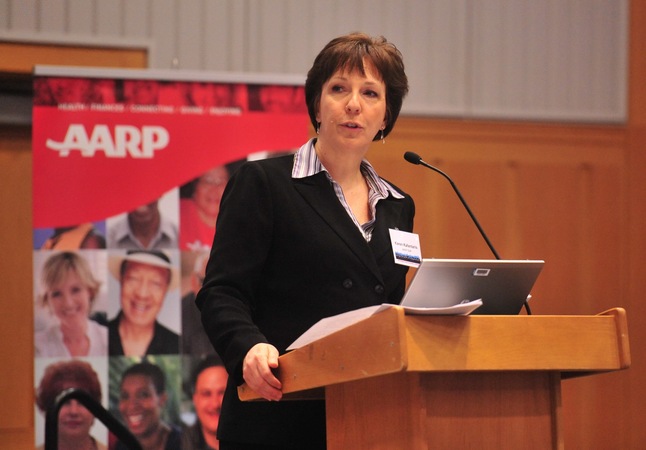
Karen Kafantaris, AARP Michigan's associate state director for livable communities, speaks at the Age-Friendly Communities Conference Thursday at the University of Michigan's Palmer Commons in Ann Arbor.
Ryan J. Stanton | AnnArbor.com
"A shift that will see 1 in every 5 Americans age 65 or older by the year 2030," said Kafantaris, AARP Michigan's associate state director for livable communities.
"That sounds like a long time, but it's only 17 years away," she said.
Kafantaris was the opening speaker at AARP Michigan's Age-Friendly Communities Conference Thursday at the University of Michigan in Ann Arbor.
Close to 200 people attended the conference held at U-M's Palmer Commons, including city managers, planners, public health officials and others from across the state.
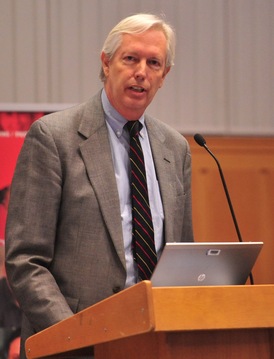
Todd Zimmerman, a New Jersey-based expert on housing and sustainable communities, talked about what communities will need to look like in the future to retain or grow their populations with the convergence of the baby boomer and millennial generations.
Ryan J. Stanton | AnnArbor.com
"Everyone who is privileged to be in a position to make a difference will be tasked with an important role in dealing with it," she said. "And when historians look back 50, 80 or 100 years from now, they're going to look and they're going to say: What did we do to address this?"
Todd Zimmerman, a New Jersey-based expert on housing and sustainable communities, talked about what communities will need to look like in the future to retain or grow their populations with the convergence of the baby boomer and millennial generations.
Zimmerman said Michigan residents age 65 and older have a combined annual income of $37 billion, they spend most of it, and they tend to spend locally. Additionally, Michigan residents age 50 to 64 have a combined annual income of $80 billion.
"And here's the 20-year opportunity of these relatively affluent folks," Zimmerman said. "Remember, this is the first generation in American history to hit their peak earning years with two earners."
Zimmerman said Michigan has an older population than the rest of the nation. In the 85-plus category, he said, it's roughly double the national average.
"And not as many young people as you should have," he said. "This is the problem and the opportunity."
Michigan must accommodate its aging population, he said, yet it also must retain and attract younger people.
"This is the crux of creating places where people can age with dignity, where people can be young with freedom, and where people can have families," he said.
Zimmerman provided a breakdown of Michigan's household categories, showing 18 percent younger singles and couples, 29 percent families, and 53 percent empty-nesters and retirees.
That compares with a national breakdown of 24 percent younger singles and couples, 30 percent families and 46 percent empty-nesters and retirees.
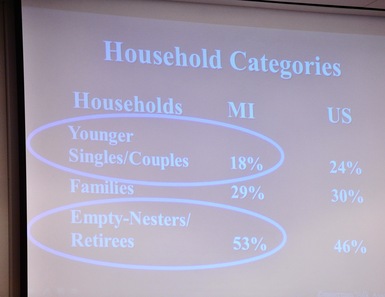
Zimmerman showed this in his presentation Thursday.
Ryan J. Stanton | AnnArbor.com
As the demographics continue to change, Zimmerman said, there's a mismatch building between the housing stock and the types of households in Michigan and across the nation, with perhaps too many four-bedroom houses with three bathrooms at the end of cul-de-sacs.
"If you were to match up the number of bedrooms in America and the number of people who sleep any given night in America, even including all the visitors, we've got a lot of empty bedrooms," he said. "If this continues, we have this threat of stagnant or declining tax base."
Single-family detached homes account for 61.5 percent of all dwellings in the U.S., and in Michigan it's 71.7 percent, Zimmerman said.
"I suspect that a higher percentage in Michigan are in those more advantageous locations, but most of the new stuff is out on the edge, and therein lies the problem," he said.
Considering 59.5 percent of all U.S. households have only one or two people living in them (in Michigan it's 61.8 percent), Zimmerman said that means the state and the nation have a housing stock built for families in a market of singles and couples.
"So where are seniors living?" he said. "A significant percentage are out in the exurbs, in the metropolitan suburbs … out on the edge."
Zimmerman said that's a national problem, and it's slightly worse in Michigan.
Connie Pulcipher, a systems planning staff member for the city of Ann Arbor, was among those in attendance on Thursday, along with members of the city's Planning Commission. She agreed communities, including Ann Arbor, have more work to do for an aging population.
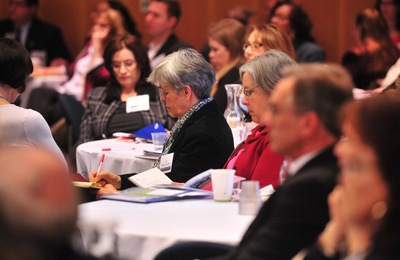
Close to 200 people attended the conference held at U-M's Palmer Commons, including city managers, planners, public health officials and others from across the state.
Ryan J. Stanton | AnnArbor.com
As far as there maybe being too many single-family houses, Pulcipher said, "I think just like any good community, we have to have a mix of housing types.
"We do have our suburbs in Michigan," she said. "But we also have some quality, close-in neighborhoods that are within a quarter-mile walking radius, and a lot of those are single detached houses, and they can work for people because of their proximity to downtown."
Kafantaris said AARP started working on the age-friendly concept last year when it partnered with Governing Magazine to conduct a series of roundtable events around the country, including some in Lansing, Philadelphia, Salt Lake City, Washington, D.C., and Des Moines, Iowa.
A key component in meeting the challenges of an aging population, she said, will be how the nation's communities successfully adapt and accommodate their aging residents by making changes in infrastructure and services that will benefit all age groups, not just the 65-plus crowd.
By 2030, when the last of the baby boomers turn 65, the 65-plus population is expected to roughly double to more than 70 million. In Michigan, it's expected to increase by about 40 percent.
"One reason I believe communities choose the 'wait-and-see' perspective is this string of myths," said Kafantaris. "The story of the retiree who packs up and heads to Arizona or Florida after they turn 65 and retire isn't as prevalent as you might actually think."
Since 1990, roughly 90 percent of older Americans have stayed right in the same county they've been living in, if not in the very same home, Kafantaris said.
AARP's research shows baby boomers also expect to do the same thing, and the No. 1 reason cited is a desire to stay close to family.
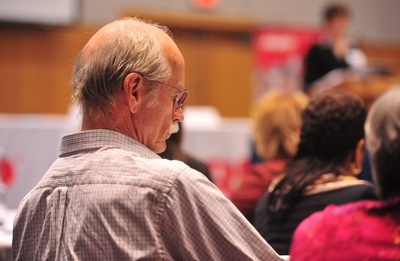
Chuck Ream, president of the Arborside medical marijuana dispensary in Ann Arbor, was among those in attendance at Thursday's aging conference.
Ryan J. Stanton | AnnArbor.com
"Livable communities are not just about serving older residents," she said. "Livable communities serve residents of all ages and we must consider all ages at every stage of the planning process — not just planning for older adults with younger residents as an afterthought."
She said residents of all ages benefit from safer, barrier-free buildings and streets, as well as better access to local businesses and more green spaces.
"Curb cuts designed for a wheel chair also benefit the parent pushing a baby stroller," she said. "A crosswalk safe for a senior citizen is crosswalk that's safe for a child. A community that is friendly for an 80-year-old is a community that is friendly for an 8-year-old and every age in between."
Another important part of the bigger picture, Kafantaris said, is that not everybody is hanging up the lunch pail at 65.
"There's a new word for retirement and it's called work," she said. "From 1990 to 2010, the labor force participation rate of people age 65 and older increased by 33 percent."
Older people also are rapidly adopting technology, Kafantaris said, citing a statistic that there are 47 million Facebook users in the United States over the age of 50.
Too many of communities are simply not preparing for their aging populations, Kafantaris said. She cited a survey conducted last year by AARP and Governing Magazine that found 16 percent of leaders surveyed said they were prepared for the changes in the next 25 years, yet 56 percent said it was extremely important and another 25 percent said it was very important that they do so.
Kafantaris said it will require creative solutions and unique coalitions involving nonprofits, government, foundations, businesses and engaged citizens.
"We just can't look to the federal government anymore," she said.
Ryan J. Stanton covers government and politics for AnnArbor.com. Reach him at ryanstanton@annarbor.com or 734-623-2529. You also can follow him on Twitter or subscribe to AnnArbor.com's email newsletters.


Comments
Mick52
Sat, Mar 2, 2013 : 9:15 p.m.
"...making communities livable for aging population benefits everyone." Really? Why? Because "residents age 65 and older have a combined annual income of $37 billion, they spend most of it, and they tend to spend locally." So its not the seniors its their money. Forget it. They are going to move to Florida where everything costs less, there is no freezing weather and a lot more seniors.
ionic
Fri, Mar 1, 2013 : 6:17 p.m.
convincing developers to build attractive, higher-density housing options in a walkable downtown and geared to our aging population is harder than one would think, given their proclivity to construct 14-story apartments that they admit is marketed only to students. no one else would rent these 4-BR units with tiny bedrooms and tinier living rooms and bike parking in the corridors. planning and zoning should address this shortcoming by how incentives are written and premiums are awarded. Approving the moratorium on City Council's agenda for Monday would give us all time to consider the intent in our city and downtown plans and guidelines, and see if we can do better for our citizens.
gbob
Fri, Mar 1, 2013 : 1:18 p.m.
After living in several communities including rural Washtenaw County, this senior is pretty happy with Ann Arbor. Good access to health care, parks, sidewalks, bus service. We have responsive police and emergency services. One area the planners need to address is more options for housing within existing neighborhoods. Perhaps mother-in-law apts. and other new creative ideas. The main drawback of the area is the weather.
Jamie Pitts
Thu, Feb 28, 2013 : 10:10 p.m.
It seems to me that downtown development is over-oriented toward the young, urban professional (and all the consumerist presumptions that come with that orientation). This ignores the other end of demographic shift, our elders. By thinking that people simply live to work, shop, eat at fancy restaurants, and sleep, we deny ourselves many human needs. I see this in the debate about whether to build a central park next to the library. The two "growing demographic groups" in Ann Arbor are not in opposition. Our elders used to be much more a part of our early-aduly lives, helping us reach middle-age in so many different ways -- emotionally, intellectually, and logistically. We should aim to make this more possible as we move toward concentrating activity downtown.
Roger Kuhlman
Thu, Feb 28, 2013 : 9:30 p.m.
You definitely do not produce livable, sustainable communities in general by increasing their population numbers. That only massively degrades our nation's biodiversity, native ecosystems, and natural habitats. America already has tremendous environmental problems due to human overpopulation which is the worst in the world due to our extremely high levels of consumption of natural resources and land. The facts of ecology will not be repealed because we choose to ignore them. An Inconvenient Truth.
TheDiagSquirrel
Thu, Feb 28, 2013 : 7:58 p.m.
The younger people should help the Baby Boomers exactly as much as they've helped them...
4Bells
Fri, Mar 1, 2013 : 1:14 p.m.
As with all generations, the boomers had our share of greedy and corrupt people. However, it wasn't the boomer's choice to be born in an unprecedented burst of population growth. We have seen this additional population stress on our resources coming for years and, to some degree, were not properly prepared for it's impact. Many boomers have been divested of promised pensions, health care and security in their retirement years, continuing to work out of necessity. To acknowledge this burgeoning problem with our elderly population is the right thing to do and is indicative of a savvy, compassionate, intelligent community that we should all feel privileged to be a part of..............
TheDiagSquirrel
Thu, Feb 28, 2013 : 8:44 p.m.
Under the baby boom generation of political and business leadership, they have bankrupted many cities with their pensions, while leaving 401K's for the younger people. They ushered in a new era of materialism and greed, and have left Social Security potentially insolvent for the younger people when they finally retire...
Zhuk
Thu, Feb 28, 2013 : 7:54 p.m.
So are you saying that AA should stop allowing developers to build student dorm monstrosities and start building more retirement oriented buildings downtown? Most of the older folks I know have nicer homes outside of the city limits. They will not move into ann arbor ever. They plan on driving until someone forcibly takes their car away from them and by that time they plan on being old and senile enough that they can go into assisted living or hospice and not realize or care about the situation they are in. How do you propose to use tax payer money to solve that? Most of the boomers/seniors I see down town who "need help" get it already from churches, the Delonis Center, and anyone with spare change.
noyfb
Thu, Feb 28, 2013 : 7:26 p.m.
Meanwhile the short-sighted brainiacs who sit on the city council thought it a great idea to invest millions of dollars in a Skate Board Park!! Instead of investing in the future!!
ArgoC
Thu, Feb 28, 2013 : 8:28 p.m.
I like the way you stay on top of these discussions, Mr Stanton.
Ryan J. Stanton
Thu, Feb 28, 2013 : 7:38 p.m.
I have a feeling you're just joking around, but for clarification for everyone who doesn't know, the city didn't put any cash toward the skatepark project, though it has donated the land and some staff time. A nonprofit group raised the money through grants and community donations, and it wasn't millions. I broke down the funding for the skatepark in this story: http://www.annarbor.com/news/ann-arbor-skatepark-construction-to-start-in-spring-with-design-now-approved/
Ryan J. Stanton
Thu, Feb 28, 2013 : 7:13 p.m.
Are you guys suggesting the city doesn't need to do any planning for this expected dramatic shift in our demographics?
Goober
Fri, Mar 1, 2013 : 12:34 p.m.
Yes - no planning needed except if you are going to help Al Gore and the other climate warming believers. If you help them make Michigan warmer during the winter months, this would help greatly. Also - you can contact Obama about the growing cost of health care. Reducing this burden would help greatly. Other than this - we do not need any other help.
Roger Kuhlman
Thu, Feb 28, 2013 : 9:38 p.m.
Maybe we should be doing some questioning of the assumption that the government does a good job of planning for future events and they should be doing this planning. The government's record on fixing many future or coming to be problems is for the most part dismal. How is the government doing with the federal debt problem and ensuring that reasonable, needed social entitlements can continue and have funding in future generations?
Ryan J. Stanton
Thu, Feb 28, 2013 : 8:38 p.m.
ArgoC - I wasn't able to stay for the full conference today. It went all day. There were sessions on housing, transportation, health care, and how to design age-friendly communities. I wish I could have stayed for it all. Every session probably could have produced a story in itself. But if it provides an assurance to you, our city planners were there taking notes and I'm sure ideas will come from it.
ArgoC
Thu, Feb 28, 2013 : 8:26 p.m.
Well the first burst of responses is usually from the really negative people. I think the answer is "of course the city should do planning ..." I wish the presentation had not been so general. We don't need to be convinced the demographic distribution is changing. (at least, I hope not). That seemed to be what the presentation was out. I'd be a lot more interested in specific ideas. And how this broad demographic group can be talked about as subgroups with different needs and solutions. And what those solutions might be. I for one am interested in ways to make the town more friendly to people who have trouble walking or standing for long periods (pre-wheelchair). To me this means certain kinds of public transit, and more places to sit, and maybe having more meeting rooms within easy reach of parking or buses.
Basic Bob
Thu, Feb 28, 2013 : 7:11 p.m.
Florida's nice. So is Arizona.
Ryan J. Stanton
Thu, Feb 28, 2013 : 8:33 p.m.
In his speech today, Zimmerman said NYC is actually the best place for seniors to retire because everything they need there is an elevator ride or a phone call away.
Dog Guy
Thu, Feb 28, 2013 : 7:05 p.m.
Opening this gathering of ex-spurts who like to count other people and take their money was the associate state director of AARP Michigan, an insurance company, and probably the last speaker not directly living on tax money. Speaking of baby boomers as "these relatively affluent folks" is difficult while heavily salivating over taking their wealth. We seniors are better able to run our own lives than are any parasitical self-designated leaders.
Top Cat
Thu, Feb 28, 2013 : 6:56 p.m.
As a 60 year old, "Seniors" do not need any more attention, accomodation, pandering to or programs from government. We have the resources, experience and cunning to figure things out for ourselves. It is young families that need the help and attention. They are being over-taxed to pay for benefits for the older asset-rich generation. Young people are being severely hurt by lack of job opportunities due to "free trade", environmental extremism and the Progressive regulatory agenda.
Goober
Fri, Mar 1, 2013 : 12:31 p.m.
I eclipse your age, Top Cat and totally agree with you. I believe our society is getting soft waiting for someone to totally take care of us. My opinion - this is pure bunk! Let us grow old in dignity. We do not need society shifting total or mass attention to golden aged citizens and ignoring our youth. Top Cat - I tip my hat to you! Go figure!
Top Cat
Thu, Feb 28, 2013 : 7:55 p.m.
There is nothing "lucky" about planning and hard work.